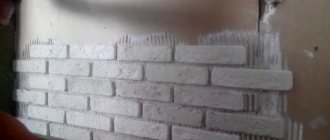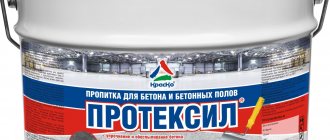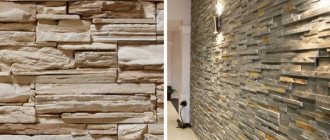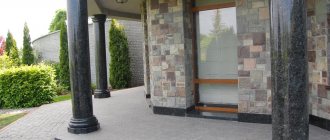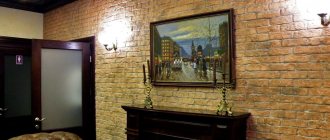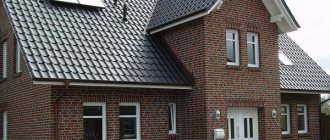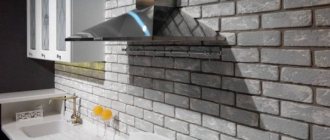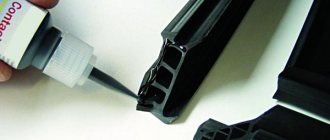The cladding is done by painting or setting the texture of concrete panels, facing the walls with brick, or installing other high-strength and weather-resistant materials.
Such elements of architectural expressiveness are made from monolithic concrete or from fully prefabricated small-piece products. In recent years, decorative concrete stone tiles have been increasingly used, which accurately imitate the structure of valuable natural materials, are not inferior to them in strength and durability, but are significantly cheaper.
What are stone products?
Decorative stone-look concrete tiles are a type of hard, wear-resistant and high-strength materials for cladding facades or for interior work, the front surface or structure of which imitates natural materials.
Products in this category are distinguished by the content of cement binder and quartz sand as fine aggregate. The coarse aggregate can be either granite crushed stone or any other types of non-metallic materials, depending on the desired visual effect.
The surface of such products repeats the polished, ground or torn structure of natural material.
Materials
Among the huge variety of tile collections presented, it is necessary to make the right choice so that the result of the construction work can please you for many years.
There are many materials used to make tiles. Each has its own advantages and negative characteristics.
Types of concrete tiles
There is a wide range of natural stone look concrete tiles on the market, which are classified according to a number of criteria, detailed below.
By invoice
Depending on the texture of the front surface, all stone-look concrete tiles are divided into the following types :
- Classic cast tiles, the surface of which is not subject to special treatment.
- Polished products that are processed with abrasives of varying degrees of grit until a glossy shine is achieved.
- Products processed using a sandblasting machine after pouring to achieve a perfectly smooth and rough surface, which provides an imitation of natural materials in the natural environment.
- Sawed plane - achieved after cutting large-sized elements with a special tool.
- The chipped surface perfectly replicates the structure of natural stone.
- Etched or washed surface - as a result of exposure to chemical abrasives or a directed powerful jet of water, the appearance of large aggregate is achieved, which gives the tile an attractive and original appearance.
It should be noted that the strength characteristics of such products are determined by the class of concrete and do not depend in any way on the category of stone that they imitate. The actual calculated compressive strength of concrete can be slightly adjusted solely depending on the type of molding, hardening conditions of the product, as well as the category of coarse aggregate and brand of cement.
By size
On sale you can find a huge assortment of stone-look concrete tiles, which are manufactured in both standard and non-standard dimensions :
The smallest products imitate brick and have dimensions of 250 x 65 mm with a thickness of 8 to 10 - 15 mm.- Miniature tiles with dimensions from 300 x 300 to 400 x 400 mm, thickness from 15 to 25 mm.
- Full-fledged products from which pedestrian paths are made in park areas - 600 x 600 mm with a thickness of 20 to 30 mm.
- Enlarged tiles with square and rectangular shapes - from 600 x 900 mm to 900 x 900 mm. The thickness of such materials ranges from 30 mm or more.
- Non-standard radius, curved or other tiles with complex configurations, which are used to organize complex ornaments or designs.
To select the correct tile sizes, the owner of a property is recommended to develop façade solutions, coordinate their colors and textures with local authorities, and then select the optimal dimensions to eliminate a large number of trimming elements and their multiplicity.
Blossom
In addition to sizes, the consumer can always choose the color scheme of concrete tiles that best suits his requirements:
- Tiles with surface painting of the front surface.
- Body-dyed products that use various water-soluble pigments.
- Using colored aggregates, marble chips, labradorite and other valuable stone materials as part of the structure of the concrete product.
Gray tiles with different tones are available for sale, as well as pastel shades - brown, yellow, sand, burgundy and other colors. When implementing an original architectural project, bright green, blue or yellow shades are used.
Experts recommend paying attention to natural pigments that do not fade, wear off or wash out over time, allowing products to retain their original shade.
According to production method
In practice, several basic methods are used for the production of textured concrete tiles to look like stone:
- Cast tiles are a classic production method, when a ready-made liquid mixture of the desired consistency is poured into formwork and then hardened under natural conditions or in an autoclave.
- Semi-dry vibration pressing is a technology when a raw material mixture with a minimum percentage of moisture is formed using submersible punches, and the structure of the material retains its geometric parameters without formwork.
- Vacuum forming is a complex technology that ensures extreme strengthening of the material in airless conditions. Experts call this technique artificial aging, since the structure completely replicates the physical and mechanical characteristics of the material that has compacted over time.
When purchasing such products, it is important for the consumer to know exactly how the tiles are made, since the porosity coefficient depends on this, which, in turn, affects the water absorption, strength and durability of the products.
By area of application
Depending on the scope of application, all concrete tiles with a stone-like surface finish are divided into 2 types :
- For outdoor use – concrete tiles, which have the lowest porosity coefficient, which prevents its destruction under aggressive environmental influences. It is installed on the facade using clamps using a pre-assembled subsystem, or using adhesive materials.
- For interior work – as a rule, miniature or full-size elements with a machined back side are laid on interior, environmentally friendly adhesives that provide increased adhesion of the material.
Despite the fact that tiles for interior use may cost less, when upgrading the facades of buildings, it is recommended to choose products for outdoor use, since they will last much longer and, in the end, will quickly pay for themselves.
How to choose material depending on the room
It is very important to choose the right tiles to decorate each room of the house. This will provide comfort to residents and increase the service life of the finishing coating. So, based on the types that are familiar to us and knowing their characteristics, we can choose where to use which type of tile.
Kitchen
Surfaces in the kitchen, and especially the wall, which is located in the area of the apron, are most exposed to steam, high temperatures, drops of grease and detergents. Therefore, for the kitchen you need to choose tiles that are resistant to mechanical damage, are not afraid of moisture, and can be washed.
This is the type that will serve in the kitchen for a long time. Very often, very popular decorative mosaic tiles are used to frame the walls in the kitchen, and especially the apron area, creating magnificent abstractions and colorful designs from it.
Bathroom
Very often, various chemical additives – detergents – are used to clean the walls and floors in the bathroom. Yes, undoubtedly, chemicals remove dirt perfectly, but not only dirt. Using similar bathroom cleaning products, we unnoticeably damage the tiles.
Chemicals not only corrode rust and soap marks, but also destroy the coating. When choosing tiles for the bathroom, you need, first of all, to pay attention to the tile’s ability to withstand chemical attack. Very often, decorative tiles are used to decorate bathroom walls - this is the best option, and this material is in great demand.
Hallway and corridor
The hallway is often a small room in which, at most, there is one blank wall, and all the rest have doors. Quite often, people choose decorative stone to frame the walls of a corridor or hallway.
Considering its high cost, it is usually used as an additional decoration. If you decorate it with decorative stone. Decorative stone is used to frame the walls around the doors. This gives the room a newness and, in part, the presence of something natural in the house.
Selection rules
Before purchasing stone-look concrete tiles, it is important for consumers to pay close attention to the following important nuances :
- Availability of a quality certificate for the products sold.
- Compliance of the material structure with the requirements of current GOSTs.
- Strength indicators of concrete products.
- Water absorption coefficient, frost resistance grade.
- Brand strength of the cement included in the tiles.
- Type of pigmentation of the material.
- Deviation of geometric dimensions from the indicators declared by the supplier, using the example of analysis of sample tiles from a general batch.
- Porosity of the front and back surface of concrete.
- Uniformity of coarse aggregate.
- Type of finishing processing of the front plane of the material.
One of the main selection criteria is the popularity of the manufacturing company, the year it was founded, as well as the customer trust rating, which is expressed in the number of positive reviews on independent forums on the Internet.
Some tips for use
It is not always necessary to use plaster to level the surface. And in terms of time, this process will be long and painstaking.
Not to mention the fact that in this case you will need additional specialized tools and a huge amount of construction waste.
Glue or cement must be diluted in certain proportions. Details of preparing the solution are written on the packaging. It is extremely important to strictly follow the instructions, as this will directly affect the service life.
When using various options for finishing walls with tiles, it is worth preparing all the necessary tools and consumables in advance.
TOP 7 manufacturers
To simplify the selection of high-quality products for paving walkways in the country, below is a rating of the 7 best manufacturers of these products, compiled based on customer reviews of these factories
Kerama Marazzi
Concrete tiles made to look like natural stone are in high demand throughout the European part of the Russian Federation .
The company was founded in 1998 in Smolensk, and is currently developing dynamically.
Average cost – from 550 – 800 rubles. for 1 m2.
Cobalt
A relatively young Moscow company that has advanced German equipment and has been producing all types of textured elements for cladding building facades since 2012.
The company constantly takes part in government orders, which significantly exceeds its rating among consumers.
The average cost is from 600 – 1000 rubles. for 1 m2.
Terracotta
The Tula enterprise was founded back in the 90s of the last century, on the basis of the old KPD plant .
In 2004, the enterprise's production facilities were completely modernized, which significantly expanded the scale and geography of sales.
Average cost – from 490 – 740 rubles. for 1 m2.
Casawaga
A unique production and trading company from Orel, it has long been focused on the production of non-standard explosive tiles for interior and exterior work based on natural aggregates from valuable non-metallic materials.
Consumers can choose products that suit their requirements from more than 120 models.
Average cost – from 800 – 1100 rubles. for 1 m2.
Monopole Ceramica
Despite the fact that the company has been operating on the basis of an old DSK in Tver , since 2008, the management has established active supplies of finished high-quality products both to the Moscow region and to other parts of our country.
The brand's products are distinguished by high quality, reliability and durability.
Average cost – from 650 – 900 rubles. for 1 m2.
EcoClinker
A large Moscow enterprise with extensive workshops and a huge range of products.
The company is often involved in the supply of products for facade work of various categories in the capital region, and consumers leave only positive reviews about it.
Average cost – from 550 – 850 rubles. for 1 m2.
Interbau
Another large Moscow company that has the most modern equipment with a high level of automation, which almost completely eliminates defects and deviations from the specified geometric parameters.
Buyers can purchase products with any configuration, in dozens of colors, with different types of finishing on the front surface.
Average cost – from 950 – 1250 rubles. for 1 m2.
The rating below is purely subjective and cannot be used as a direct guide to purchase, as it is advisory in nature.
Walls
Decorative brick-like tiles are a universal option for decorating rooms of different purposes. Purchased options may not always satisfy you with their cost or appearance. In this case, it is better to make brick tiles with your own hands. We’ll talk further about the step-by-step work on making decorative brick tiles by hand.
Content:
Manufacturing technology of decorative gypsum brick tiles
Gypsum stones have good performance characteristics and are widely used for interior decoration. This is explained by the following advantages of this material:
- environmental safety and harmlessness;
- additional humidifier in the room;
- high practicality of the material;
- good performance characteristics;
- possibility of coloring;
- affordable price.
There are a large number of methods for making gypsum decorative stone. Some craftsmen add additional components to the composition in the form of lime, lemon, glue. However, classic recipes for preparing gypsum tiles involve the use of gypsum and water.
With the help of gypsum tiles, you can decorate the room in various styles. It suits almost all modern trends. Plaster tiles add elegance and sophistication to the room. In addition, it can be used to hide minor wall defects, such as uneven corners or ceilings.
Some designers use gypsum tiles to decorate arched openings, plasterboard partitions, fireplaces, and stairs. The tiles have a pleasant texture that decorates the room, making it more attractive.
However, gypsum tiles also have a certain disadvantage. It consists primarily of the low strength of this material. Comparing cement and gypsum tiles, the second option is less durable. To improve this indicator, special substances are added to the tile preparation solution; most often they have a polymer base.
We invite you to familiarize yourself with the advantages of using gypsum stone when constructing tiles at home:
- the presence of convenient forms speeds up the process;
- the technological process does not require a vibrating table;
- the material is easy to paint;
- compositions for making tiles are affordable.
Building gypsum stone at home will not be difficult if you approach this process with great responsibility and seriousness.
To make brick tiles from gypsum, you will need special molds. It is best if they are made of silicone. Since the material, after hardening, is easily removed from the mold without damage. Buying silicone molds will not be cheap, however, they can be used repeatedly, not only for making tiles.
Polyurethane molds are more expensive and are suitable not only for the manufacture of gypsum tiles, but also for cement tiles, as they are able to withstand alkali. The service life of such forms is much longer than silicone ones.
In addition, during the production of tiles, a special container will be required in which the gypsum mortar will be mixed. We recommend giving preference to plastic products, as they are easy to clean.
The combination of gypsum and water without additional impurities will create tiles with a high level of fragility. This material is not suitable for finishing the room. Therefore, additional lime must be added before adding water to the gypsum.
To mix the solution, use a drill and a mixing attachment. Pour the resulting solution into the mold and wait until it dries. Please note that the form must be placed in a room free of drafts and frost.
Prolonged mixing of gypsum is unacceptable. Since the material sets quickly and does not harden in the future. If you find bubbles on the surface of the solution, then place the form with it on a vibration table for one hour.
To make colored decorative brick tiles, dye is added to it during the mixing process. Special coloring compositions are characterized by high cost and low service life. An alternative replacement is dyes that can be used to tint paint.
According to the advice of some experts, adding cement to the gypsum composition will increase its strength. However, such tiles lose their antiseptic properties and quickly become covered with fungus and mold.
When making decorative brick tiles from gypsum, you need to take into account the following recommendations for working with this material:
- In the absence of additional plasticizers that ensure the strength of the finished material, they are replaced with citric acid in a certain proportion.
- The hardening time of the gypsum is fifteen minutes, then it is removed from the mold. The finished tiles are dried on a flat surface for several more hours.
- Please note that gypsum mortar is only suitable for one pour of molds, as it quickly becomes unusable.
DIY decorative tiles to resemble white brick
Gypsum is also used to make white decorative tiles. At the same time, we recommend purchasing GF10 brand material for these purposes. This version of gypsum has high strength and has good performance characteristics.
If you were unable to purchase such gypsum, then it is enough to add special hardeners to the solution to improve the properties of the material. Please note that gypsum tiles are used exclusively for interior decoration of rooms. Gypsum does not tolerate sudden temperature fluctuations and moisture.
In the process of manufacturing decorative tiles for brick finishing, you will need:
- gypsum;
- plastic mesh for reinforcement;
- candles, namely paraffin;
- cardboard box;
- plasticine;
- silicone based sealant.
To make your own bricks from gypsum, you also need to stock up on sculptural plasticine. This material is rolled out into a layer about 20 mm thick. Next, using a brick, they create impressions on it. In this way, it is possible to obtain a form in which the material will be cast.
The second option for making a mold involves the use of paraffin. Find a box the size of a brick, melt the paraffin and pour it into it. After it hardens, remove the tile. Also, an alternative to paraffin will be a silicone-based sealant; it is poured into a box and, after hardening, removed from there.
The time for making brick tiles depends on the number of ready-made forms; the more forms you build in advance, the faster the process of making tiles will go. Gypsum is poured into a container with water and diluted to a creamy consistency. The molds must first be greased with vegetable oil or fat. To distribute the composition evenly throughout the mold, after pouring it, shake the finished structure. If there is water separating from the plaster on the mold, the composition must be discarded and a new solution must be prepared.
Next, a mesh is laid on the surface of the form, which performs the function of reinforcement. It should be slightly recessed in the solution. Thus, it is possible to make decorative bricks, which can be used to decorate walls, fireplaces, stairs and other parts of the room.
Laying decorative gypsum tiles under brick
In order to install gypsum-based tiles, you will need to use one of the adhesive options described below:
- standard cement-based tile adhesive - it can be used to lay any finishing coating;
- gypsum-based plaster is the best option compared to the previous one; with its help, it is possible to properly fix the tiles to the surface;
- silicone-based sealant - ensures high-quality adhesion of the tiles to the wall.
The surface to be laid must be flat and free of previous finishing. In addition, it should be covered with two layers of deep penetration soil.
To install tiles, follow the instructions:
- Apply a small amount of glue to the wall surface.
- An adhesive composition is also applied to the surface of the tile.
- Install the tile, determining its position.
- To obtain even seams, use plastic crosses.
- Excess glue is removed using a rubber spatula.
Brick-like decorative tiles for interior decoration made from Portland cement
During the work process you will need:
- brick-shaped cardboard boxes;
- white Portland cement;
- liquid cement sealant;
- two types of sand: regular and quartz;
- foam balls;
- reinforcing metal mesh;
- rubber gloves.
Initially prepare a box the size of a brick; it should have a rectangular shape. The size of decorative brick tiles is determined individually, in relation to the purpose of using this material. Next, lay a thin metal mesh on the bottom of the box. In order to prepare a solution for pouring, use foam balls, water, regular sand and quartz sand in a ratio of 1:2:1:1.
Next, white Portland cement should be gradually introduced into the composition, the mass is mixed until homogeneous and left for 15-20 minutes to infuse. After this, the viscosity of the solution will increase slightly. Put rubber gloves on your hands and start shaping the brick. The composition is placed in a previously prepared box, then with the help of cutting tools it receives the desired shape. Complete hardening of the composition occurs after 24 hours from the moment it is poured.
Next, the coating solution is applied to the surface of the finished bricks. To prepare it you will need water, quartz sand and Portland cement. They are combined in a ratio of 3 to 1 to 1. Initially, the outer part of the brick is coated, after it dries, the solution is applied to the other side. Thus, it is possible to achieve ideal smoothness of the coating.
To paint bricks, a special acrylic-based paint is used. It is diluted with water to a semi-liquid consistency and applied to the surface. To obtain a more natural result, you need to mix several colors together. Try to apply several thin layers to the surface.
To fix the result obtained, a cement-based sealant is used. To apply it, use either a brush or a spray bottle; the second option is more convenient. With the help of a sealant, it is possible not only to fix the paint, but also to give the brick additional strength.
Creating and laying decorative brick tiles from putty
When working on tiles you will need:
- acrylic-based putties;
- meshes with reinforcing properties;
- wooden slats;
- screwdrivers;
- rubber spatula;
- acrylic-based brushes and paints.
Acrylic putty allows you to imitate the surface of brick directly on the walls of the room, and paints will help you achieve the desired color effect. Initially, the reinforcing mesh is fixed to the wall. A stapler or nails are used for these purposes. Next, markings are made for the brickwork. First, the slats are installed horizontally and then vertically.
After this, putty is applied to the wall using a spatula. To create a textured surface, individual sections of the wall are scratched, creating chips. An alternative replacement for acrylic putty is gypsum putty; it can also be used for these purposes.
After the composition has completely dried, the slats are dismantled. In order to hide the reinforcing mesh, dilute the putty with water and coat the gaps between the resulting bricks. If necessary, scratch the surface further with sandpaper.
Next comes the process of painting the finished wall. To do this, you will need to use acrylic-based paint of the desired color.
A simpler option for creating brick paint on a wall is to apply putty to the reinforcing mesh and press through the brick seams with a lath. After the putty has dried, the surface is sanded with sandpaper and the brickwork is painted.
Flexible decorative brick tiles
Flexible brick tiles are suitable for both interior and exterior decoration. It contains components in the form of:
- sand;
- polymers;
- colored dyes.
These components allow you to construct products of various shapes, colors and performance characteristics. Among the main advantages of flexible tiles are:
- the high level of strength and practicality of use are ensured by the binders that make up the tile;
- the service life of such tiles is much longer than that of gypsum or Portland cement tiles;
- the tiles are resistant to water and moisture;
- the material is resistant to temperature changes and has an anti-slip coating;
- The tile retains its color for a long time and is also resistant to aggressive substances.
Flexible tiles are easy to install and practical to use. If necessary, it is possible to dismantle the coating and reinstall it. The variety of textures of flexible tiles allows you to choose a material that suits any style.
Tools and accessories for the device
To independently lay concrete tiles on the facade of wall cladding, or when performing interior finishing work, the master will need the following set of tools and devices:
- For plane measurements and marking:
- Level.
- Laser rangefinder.
- Roulette with a length of 5 m.
- Laser or bubble building level.
- Nylon lace for setting the horizontal mounting plane.
- A plumb bob with a weight to check the verticality of the mounting plane.
- For installing tiles on the facade:
- Steel angle for temporary support of the first row of tiles.
- A drill or hammer drill with a set of drills for fastening mounting parts and subsystem elements.
- Clasps, hooks and other elements to ensure mechanical fixation.
- Rule for smoothing the applied adhesive composition.
- Mixer for mixing glue before installing tiles.
- Galvanized steel profiles for organizing conductors when installing several rows in tiles.
- Sealants with a gun for sealing installation joints between the plinth and the blind area, or between hanging ebbs upon completion of tile installation.
- Spacers to create a uniform seam between piece elements,
- For laying tiles in the interior:
- Container and mixer for mixing liquid adhesive composition.
- Rule for smoothing glue.
- A spatula with a notched end for forming an adhesion plane after applying adhesive to the back of the tiles.
- Rubber spatula for grouting.
- A tool for cleaning the room upon completion of work.
To achieve the expected result, it is recommended to choose only high-quality, serviceable and well-sharpened tools.
Where can tiles be used?
All finishing work can be divided into:
- Internal;
- External.
Based on where the repairs are planned, the appropriate type of building material is selected.
Manufacturers offer a huge range of products, each with its own advantages or disadvantages, so when going to the store, it is better to be “savvy” on the topic.
Decorating walls with tiles is a relatively new type of decorating residential premises, but it is gaining momentum due to its practicality and durability.
Step-by-step instructions for installation steps
Laying concrete tiles under stone on a facade or indoors is a responsible process that requires the involvement of professionals. If this is not possible, you can do all the work yourself, provided you carefully follow the step-by-step instructions given below.
Indoors
To install concrete tiles in the interior, you must follow all the steps of the following algorithm :
The surface of load-bearing or enclosing vertical structures in the interior is cleaned of dust, dirt and other debris.- A leveling plaster layer of cement-sand or gypsum mortar with a specified thickness is installed.
- If necessary, utility lines are installed in the thickness of the plaster.
- Mix the tile adhesive in a separate container, according to the recipe on the bag.
- Arrangement of templates for selecting the desired masonry trajectory of the first row.
- Installation of a supporting corner to distance the elements of the final wall covering from horizontal structures, which helps compensate for thermal expansion and contraction.
- Laying the first row, in accordance with the development of wall structures.
- Monitoring compliance with geometry when laying the first row.
- Installation of the entire wall plane in the room with setting the required gap between the tiles at the selected height, according to the drawings.
- Trimming the edges of products, if such an operation is required after measurement.
- Arrangement of utility network outlets, if necessary.
- Refinement of the plane with laying of multiple elements of the vertical plane.
- Filling joints, grouting, checking the installation plane.
After grouting the joints, it is recommended not to use the room and not to change the temperature and humidity conditions for 24 hours, for reliable polymerization of the cement-sand or other adhesive composition.
Outside
To install concrete tiles with a natural stone texture when performing facade work, or when cladding the basement of a residential building, it is necessary to complete a certain technological map :
- Measurements of the façade plane, identification of defects and deviations from orthogonal axes.
- Applying markings, installing horizontal lines and vertical plumbs.
- Installation of beacons for applying exterior weather-resistant plaster.
- Installation of a subsystem for mechanical fixation of tiles (if necessary).
- Arrangement of supporting profiles for the installation period.
- Mixing the adhesive composition.
- Laying the first rows, fastening small-piece concrete products to clamps with control of filling the gaps with mortar.
- Checking the geometric position of the first row.
- Installation of all subsequent rows with the required dressing and spacing the parts from each other using steel rods or polymer spacers.
- Sealing of junctions with dissimilar structural elements of the façade.
- Framing of window and door openings
- Grouting joints.
- Checking the quality of work performed and, if necessary, eliminating errors.
The space between the tiles should be filled with a semi-rigid cement-sand mixture, which acts as a grout and also prevents precipitation from penetrating under the hard surface, which significantly extends its service life.
Photos of options for decorating the hallway and corridor with decorative stone
Decorating a hallway with decorative stone often means finishing corners and doorways
Decorating an arch with decorative stone and a switch
Two options for finishing the door with artificial stone
It can be difficult to beat a doorway
Two different styles, same material
There may be very little finishing
Alternating stripes of plastered walls and decorative stone gives an unusual effect
If you play with light, it will turn out even more beautiful
In modern interiors, imitation brickwork is often used
One of the walls in the corridor is decorated with decorative bricks
What’s good about this option is that all “dirty” places are covered with stone
Possible difficulties in the process
When installing concrete tiles with their own hands, beginners may encounter a number of serious problems :
Peeling after the first season of use. The entire space under the tiles on the facade must be filled with a rigid mortar, which, when polymerized, creates a uniform structure.- Uneven seams between individual elements after installation. When installing concrete products for the facade and interior, it is recommended to use templates from reinforcing bars or plastic crosses to form equal gaps between them.
- Violation of the single plane of the facade - the installation of this textured tile is highly complex and requires control of the installed products in each row, both in the horizontal and vertical directions.
- Cracking of materials before the deadline set by the manufacturer - it is recommended to purchase products only from trusted suppliers who have a certificate of conformity with specifications issued on the basis of current GOSTs.
To avoid this, it is recommended to carefully follow the recommendations of professionals, which they share with other users on many construction forums on the Internet.
Disadvantages of gypsum products
On the Internet you can find photos of wall decoration with tiles, but only when you start renovation work does it become clear that not everything is as simple as it seems at first glance.
To avoid mistakes, it is worth considering such disadvantages as:
- Highly susceptible to mechanical damage;
- Difficult to maintain (accumulates dust);
- It is necessary to treat with special solutions that prevent moisture absorption.
When compared with other building materials, this has a minimal number of shortcomings, and with proper organization of care, it will not cause trouble for the owners.
DIY making
In some cases, concrete tiles can be made with your own hands, which is especially important if the cladding is done for a small private house, or the owner needs to lay out a small area of internal walls (for example, in a vestibule or on a porch).
What is necessary?
To make concrete tiles imitating natural stone, site owners will need the following materials, a set of tools and other equipment:
- Materials:
- Dry cement of the selected brand.
- Fine aggregate – quartz washed sand with a uniform granulometric composition.
- Coarse aggregate - granite crushed stone, marble chips, slag rocks, basalt materials or other types of natural stone.
- Aramid fibers (if structural internal reinforcement of tiles is necessary).
- Pigment compositions to achieve the desired color scheme.
- If it is necessary to ensure increased plasticity and weather resistance, use plasticizers in liquid or dry form.
- Tools:
- Scales for dosing ingredients with a load capacity of 100 kg and above.
- Boards or steel sheets for assembling formwork.
- Textured shape imitating natural stone for the front surface of the tile.
- A concrete mixer or drill with a mixer attachment to mix the solution after adding all the ingredients.
- Deep vibrator or table with vibration supports for effective compaction of freshly laid mixture in formwork
- A trowel and a rule for smoothing the plane after laying the resulting mixture into the formwork.
- Oil with a brush for lubricating the inner surface of the formwork.
- Buckets, stretchers and other containers for transporting liquid mixtures.
- A steel screwdriver, a hammer, a wide-blade chisel, construction knives and other flat cutting tools for successfully delaminating the formwork after the concrete mixture has hardened.
- A set of disc abrasives for refining the resulting plane after removing the stone material from the formwork.
It is recommended to choose only pure ingredients that have an optimal level of moisture and do not contain clay impurities, which will significantly improve the quality of the finished product.
Process
To make concrete tiles with your own hands, you need to follow step-by-step instructions :
Dry materials (cement, sand, coarse aggregate, pigments and plasticizers) are mixed in the required proportions until a uniform consistency is achieved.- The required amount of water is added to the dry mixture.
- The solution is thoroughly mixed in a concrete mixer or using a mixer.
- The formwork is assembled from individual elements. It is important that the sides of this design can be easily folded back.
- The inner plane of the mold is lubricated with oil to avoid unwanted adhesion and subsequent delamination of the material.
- The required amount of liquid solution is poured into the mold.
- The formwork must be assembled in such a way that when pouring the front plane faces down.
- The concrete structure is vibrated with a special tool.
- The surface of the freshly laid material is smoothed until a smooth plane is achieved.
- After hardening, the finished product is removed from the formwork.
- The tiles are washed with a stream of clean water.
- If necessary, mechanical modification of the front plane is carried out.
It should be noted that concrete gains 100% strength only 28 days after the start of hardening, and 70% - no earlier than 6 - 7 days after pouring.
Advantages and disadvantages
Concrete tiles with decorative stone imitation are in wide demand among consumers due to the presence of a number of undeniable advantages:
- High strength of products.
- Minimum porosity coefficient.
- Attractive appearance
- A wide range of shades, textures and types of processing of the front plane.
- Increased degree of frost resistance and water resistance.
- As a rule, only natural materials are used in tiles, which ensures a high level of environmental friendliness.
At the same time, despite the advantages, such materials have some disadvantages, which is why a number of land and house owners often choose other products as floor coverings or for constructing walkways :
- The cost is higher than standard products.
- When making concrete surfaces, it is necessary to maintain a minimum thickness of 10 - 15 mm.
- Difficult to install.
- The need to install a plaster base to prevent disruption of the plane of the hard coating of the facade or internal walls.
- Increased dead weight, which significantly increases the cost of logistics.
Considering that most of the disadvantages are subjective, most property owners prefer these products to other materials, which helps maintain demand for them.
Artificial stone or concrete tiles
In terms of composition and manufacturing technology, facing tiles made of artificial stone are lightweight cement-sand concrete, which is reinforced with polymer or natural fiber. Sometimes crumbs and screenings of natural stone (marble, granite, limestone) are used as filler, but more often dyes and molds (stamps) with a characteristic relief of the front part are used to imitate the texture.
Thanks to fiber reinforcement, the tiles are durable and resistant to fracture loads.
And the strength to compressive loads of concrete is already quite high. Adding pigments to the solution during the manufacturing process ensures resistance to fading and moisture. And although decorative tiles are inferior to granite in frost resistance, they are no worse than limestone, sandstone or brick, which they most often imitate.
If we evaluate decorative qualities, then artificial stone is not inferior to natural analogues and facing bricks in terms of texture diversity, and is even superior in color palette. Although an experienced builder will always distinguish what kind of material is in front of him by the repeating pattern of the relief.
The installation technology in most cases is similar to laying clinker or ceramic tiles - laying is carried out on a pre-prepared leveled surface using an adhesive solution, followed by jointing. Trimming and adjusting sizes is much easier than with stone tiles - in addition to a grinder with a diamond blade, you can use a regular hacksaw for metal.
For suspended facades, specially designed load-bearing systems are produced that allow decorative tiles to be fixed to the sheathing with metal fasteners.
Average prices for installation work
On the Internet you can find many commercial officially registered organizations that offer installation of concrete tiles on the facade or in the interior. Considering the high level of competition between these companies, prices for their services are approximately the same, regardless of the region of the Russian Federation :
Dismantling the old coating (if necessary) – from 400 – 550 rubles. for 1 m2.- Installation of a plaster base from – from 450 – 550 rubles. for 1 m2.
- Installation of concrete tiles in a staggered pattern, using a row system, or with chain ligation of seams - from 400 - 450 rubles. for 1 m2.
- Installation of concrete products with a pattern and several shades - from 600 - 650 rubles. for 1 m2.
- Installation of concrete tiles with a lot of trimming, with different thicknesses and textures - from 750 - 900 rubles. for 1 m2.
- A set of works on the installation of facade elements with preparation of the installation plane, marking, laying tiles and grouting joints - from 1200 - 1400 rubles. for 1 m2.
The final cost of work, as a rule, is determined on the basis of an estimate, which takes into account both basic prices and adjustment factors depending on the volume of work, the complexity of installation, as well as the company’s internal pricing policy.
Decorative ceramic tiles
This is a whole family of tiles made from red and white clay, with different production and decoration technologies. The most famous include:
- Majolica. This is double-fired ceramic. After the first firing (at a temperature slightly above 1000°C), the tile is covered with glaze, a design is applied and fired again. Glaze and paint are sintered into a relief design. If we discard the “Spanish” roots, then in our country it is also known as Dutch or tiled.
In addition to finishing kitchens, they are used to decorate fireplace portals or stoves, window and door openings, and make decorative panels. - Terracotta. Single-fired ceramics, which is made from colored clay without additional coloring (sometimes glazed). Used for finishing walls and facades, lining fireplaces and stoves. Visually it resembles ceramic or clinker brick with a rough surface.
- Cottoforte. Double-fired red clay ceramics. It has a matte, non-glazed surface. The main purpose is interior wall decoration.
- Cotto. Single fired red clay tiles. As a rule, matte. The firing temperature is low, and to ensure resistance to moisture, the tiles are treated with hydrophobic compounds. Used for finishing inside and outside. The color is natural, from ocher to reddish-brown.
